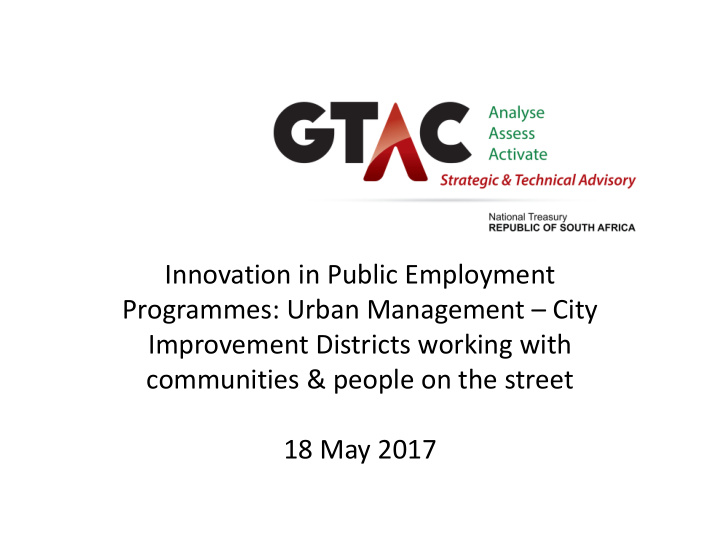



Innovation in Public Employment Programmes: Urban Management – City Improvement Districts working with communities & people on the street 18 May 2017
Urban Management Concerns • Cities showing increasing concern on role of Urban Management to improving Area-based or Neighbourhood Business Environment & Overall Investment Climate • Urban Management Key to Urban Regeneration • What are the Fiscal Incentives & Policy Instruments to support Urban Regeneration? • Is Urban Management an Opportunity for Public Employment Programme Innovation? • Mapping City Economic Development interests to PEP innovation
Role of City Improvement Districts A CID = defined geographic area in a city where majority of property • owners (usually 75%) have agreed to pay for supplementary or ‘top up’ services to those provided by the City Special Rating Area or SRA • City still provides basic services, muni roads, street lighting, traffic & • parking Top up CID services may include additional cleaning & maintenance, • public space upgrading & maintenance, additional security services Higher order services may include web based & IT services that • connect businesses in the area; business attraction & retentions services; event management etc. Objective is to maintain & manage public environment & public space • in way that promotes Good Place to do Business – raises investment potential
Role of City Improvement Districts A CID = defined geographic area in a city where majority of • property owners (usually 75%) have agreed to pay for supplementary or ‘top up’ services to those provided by the City City still provides basic services, muni roads, street lighting, traffic • & parking Top up CID services may include additional cleaning & • maintenance, public space upgrading & maintenance, additional security services Higher order services may include web based & IT services that • connect businesses in the area; business attraction & retentions services; event management etc. Objective is to maintain & manage public environment & public • space in way that promotes Good Place to do Business – raises investment potential
CT Central City Improvement District • Cape Town Central City Improvement District (Cape Town CCID) • Well established & resourced CBD CID (2000) • Integrates Urban Management objectives – clean, attractive & reduced risk environment for Doing Business – with.. • Social Development objectives – Working with Street People – over 7000 in CT – often seen as source of urban social concers • Partners include shelters & vocational training NGOs • Also Khulisa Social Solutions – engages in work-based rehabilitation for homeless & environmental responsibility; and Straatwerk – rehabilitation NGO • Pro-actively address homelessness & anti-social behavior – the role of ‘Economic Agency’ in working
Khulisa Streetscapes Phase 1: Work Readiness – Recovery “Humanising the Urban • Poor” Working with CoCT EPWP and WCG Dept of Social • Development on using EPWP stipends – mixed experience Interesting examples of integrating homeless into work • activities as part of Urban Management that are NOT just street cleaning Fruit & Veg Garden on Roeland Street within the East City • Precinct Inner City Bakery – Mamma Mimi Bakery • Recycling Transfer Station collecting waste from Inner City • businesses Soap Manufacturing for Hotels Inner City • New Opportunities: Inner City/ Urban Roof Top Gardens with • Vega Advertising & Wellness Warehouse Inner City Social Capital & Cohesion – Interdependent future •
CoJ: eKhaya Voluntary CID • Voluntary CID = neighbourhood partnership programme that organizes community involvement based on property ownership into a voluntary neighbourhood association with an associated constitution. • Voluntary CID or neighbourhood partnership often 1st first stage to establishing a formal CID, • eKhaya Neighbourhood NB case study of a residential voluntary CID in the Hillbrow area critical to area turnaround & regeneration. • eKhaya established in 2004 in Hillbrow through the initial efforts of two landlords in the area – the Johannesburg Housing Company (JHC) and Trafalgar Properties. • Employed a community organizer who convened 4 main landlords responsible for 8 blocks in the area and key City role players
CoJ: eKhaya Voluntary CID 2 nd phase eKhaya Neighbourhood Association formed action plan • around crime and grime. Initiated a security project using a basic security force on the • ground that had experience in working in the area. A cleaning intervention introduced contracted street cleaning to • liaise with the City’s Pikit-up and Region F to keep the pavement and street areas clean 3 rd phase eKhaya built on its success of reducing crime, improving • security, ensuring a cleaner neighbourhood & mobilizing community operation through community activities that includes an eKhaya Street Sports project, Annual Kidz Day project, and Neighbourhood networking More broadly eKhaya raises the potential for collaboration • between a voluntary CID, City urban management and capital project upgrading, and a bottom-up approach to security and cleaning as well as even community development projects using PEPs CWP as a mechanism to involve community members in service delivery on a public employment approach
CIDs & Potential for PEPs More broadly eKhaya raises the • potential for PEP innovation Specifically collaboration between a • voluntary or formal CID, City urban management, a bottom-up approach to security & cleaning and community development projects using PEPs as a mechanism to involve community members in service delivery on a public employment approach In lower income or emerging urban • nodes do Public Health & Education facilities provide the anchor tenants that support a voluntary CID working with PEPs on emerging node urban management
Thank You
Recommend
More recommend